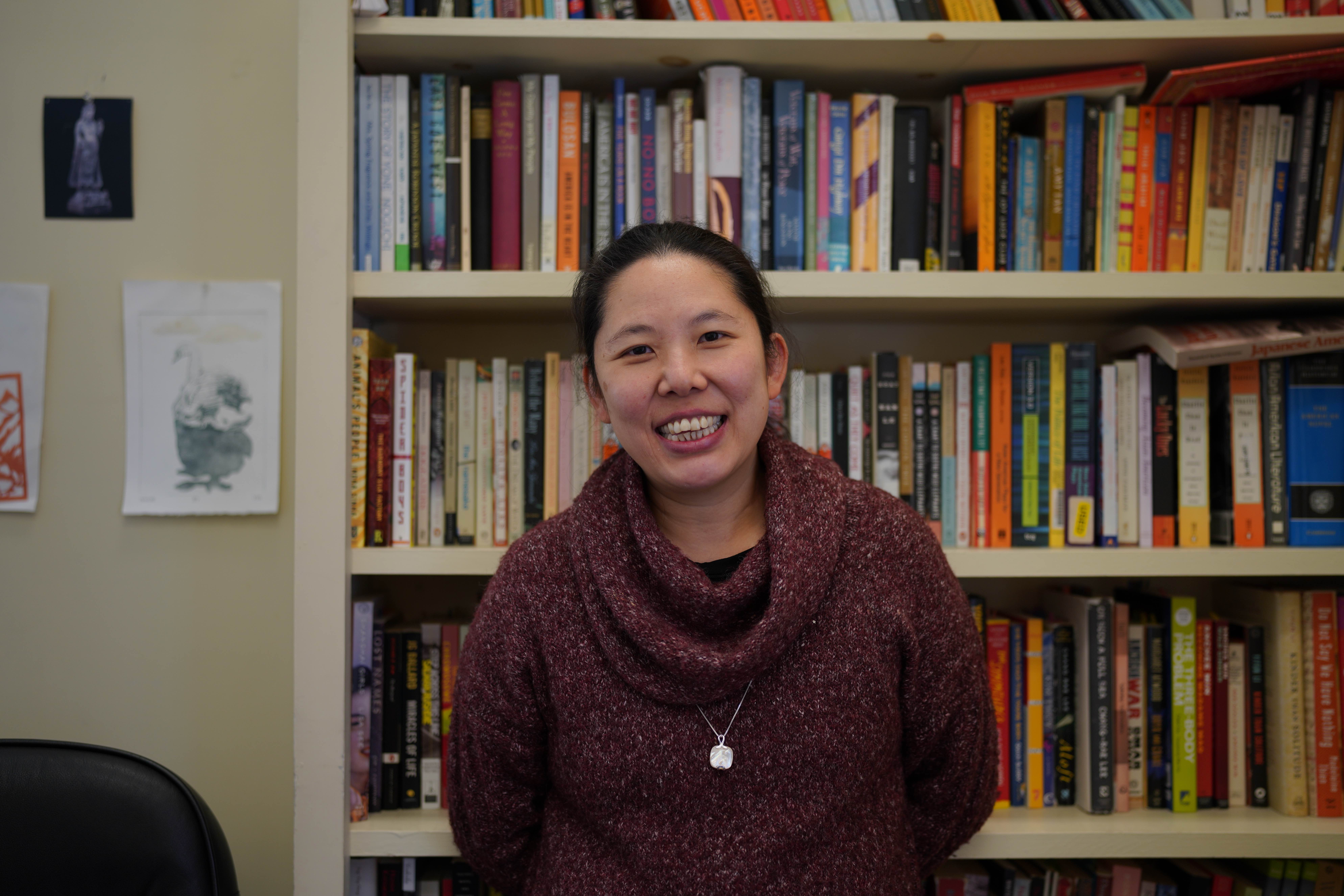Grades soar in wake of pandemic changes
Professors reenvision the Bowdoin classroom with flexible grading methods.
February 3, 2023
For decades, the Book Award has been among Bowdoin’s most respected badges of academic success, awarded each October to students who have taken a full course load and received a 4.0 grade point average the previous academic year.
The prize has been awarded yearly since its inception in 1941, but suddenly, this once-exclusive prize has become easier to win—by a lot. The number of winners has more than quadrupled over the past couple of years, smashing through the previous record of most winners set in 2002, a year before Bowdoin introduced pluses and minuses to its grading system.
Faculty members say the surge in straight-A students reflects a change in grade standards during the Covid-19 pandemic, combined with changing classroom values. In interviews with the Orient, several faculty members said they modified their assessment practices—including weighting student effort more than mastery of course material—both to lessen the advantage of students from privileged educational backgrounds and also to emphasize learning over evaluation.
Statistics from Sarah and James Bowdoin Day programs put the trend in a vivid light. In 2019, the last year before the pandemic, 35 students received the Book Award. In 2021, there were 147 students who took home the award and 144 students in 2022. In 2020, the annual ceremony was canceled.
The Book Award figures are just one illustration of a wider phenomenon reshaping Bowdoin’s academic program. Faculty interviews show widely divergent views about whether the trend toward more generous grading is a good sign, reflective of more engaged and inclusive classrooms, or a sign of what they call “grade inflation” and diluting academic rigor.
Kathryn Byrnes, director of the Baldwin Center for Learning and Teaching and professor of education, is one of the faculty members encouraging a shift toward more effort-based grading. She said that in a successfully taught course, most students should be able to receive A’s and B’s.
“It’s an exclusionary model of education—the way we’ve often thought about grading, [in which] only a few people can do this well,” Byrnes said. “Whereas if you really think, ‘No, I’m here to educate all my students,’ everyone should be able to do well in this class.”
On the other end of the spectrum are professors like Professor of Psychology Samuel Putnam, who is known for strict grading. He said that more lenient grading can diminish student effort and nullify the value grades have as a tool of evaluation.
“I think it’s unfair to these excellent students, and I think it’s unfair to graduate programs,” Putnam said. “Would you like your doctor to go to a college where everybody gets all A's?”
Professor of Gender, Sexuality and Women's Studies and Senior Vice President and Dean for Academic Affairs Jennifer Scanlon said she is concerned by the Book Award numbers but expects them to return to pre-pandemic levels over time, even as she said that there is little possibility that the Office of the Dean for Academic Affairs will institute any measures to regulate grading.
“I do think there will be a recalibration over time,” she said. “There is not going to be some uniform directive that comes down from the dean’s office about how people have to grade.”
Bowdoin’s grading system has undergone changes over the decades. In 1990, it switched to a traditional A, B, C, D and F grading system from the four-level pass/fail system it had originally adopted in 1967. In 2003 it incorporated pluses and minuses into the letter grading system.
Rising grades is also a trend that precedes Covid. The Office of the Registrar stopped publishing the College’s average GPAs about a decade ago, but the Orient’s archives show that the College’s average GPA rose steadily from the 1990s to the 2010s. The number of Book Award recipients climbed gradually in the 2010s.
Whatever one’s views are about grading, interviews with students and faculty members highlight how teaching changes required by the period of remote learning incurred effects that are likely to echo for years.
The virtual classroom and its trail
During remote learning in 2020 and 2021, faculty members adopted a variety of new measures at the suggestion of the Office of the Dean for Academic Affairs to make the online classroom conducive to learning and ease student anxiety.
Some professors began to adopt non-traditional forms of grading like labor-based grading and mastery grading. Labor-based grading is the practice of grading students on the basis of time and effort, rather than the quality of the work. Mastery grading means allowing students to revise their work prior to final grades.
Built on similar ideas, these forms of grading, advocates argue, attempt to take into account the differences in preparation that students enter a course with and promote greater risk-taking and learning.
The College instituted a mandatory Credit/No Credit grading system for one semester in Spring 2020. Although Bowdoin eliminated that grading system in Fall 2020 and returned to mostly on-campus learning by Fall 2021, the effects of these changes still reverberate, affecting not just the distribution of grades but also the culture of the Bowdoin classroom.
During the remote learning period, Professor in the Natural Sciences Barry Logan switched to frequent, smaller assessments in lieu of a midterm. Logan anticipates sticking with this practice permanently, given the pressure that it takes off individual assignments.
“If [any] one of [the assessments] goes terribly wrong for somebody, it’s not as dire,” he said.
 Cora Dow
Cora DowPrior to Covid-19, Associate Professor of Asian Studies and English Belinda Kong used a grading rubric to evaluate student papers. She stopped this practice during the pandemic because it was difficult to teach writing skills to her students, so she graded students on the basis of engagement instead. She observed that her students’ papers were more creative as a result.
“Once I let go of what I had imagined a literature paper had to be and I opened up to the different ways that people wanted to write about the literature, I found that I actually had a higher level of engagement,” Kong said.
Byrnes agreed: “students are much more likely to take risks when they are not immediately going to get a grade for it. And those kinds of creative risks are what intellectual rigor is, right?”
Ari Geisler ’23, a math and physics major, said grades motivate him yet also diminish his excitement for the material.
“In courses where I know there is grade flexibility … I choose to do my homework rather than dread working on it,” Geisler said.
Assistant Professor of Anthropology Willi Lempert said that before Covid, professors at the College, including himself, tended to view the quantity of work assigned as a marker of rigor. He has since moved away from this mindset.
“I’ve realized there’s a difference between the maximum amount people can do and the optimal amount that we would all get out of our goalposts,” Lempert said.
Rachel Nealon ’23, a chemistry major, said she appreciates when professors are willing to grant extensions on deadlines, another tendency that has become more commonplace since 2020.
“On paper, it’s like, ‘Oh, you have a deadline; people should be able to meet it,’” Nealon said. “But life happens.”
Byrnes, who adopted labor-based grading last spring and has helped other professors implement the practice, said labor-based grading seems counterintuitive at first, but actually works hand in hand with equitable learning in a way that traditional grading does not.
“When you first read about labor-based grading, especially as a person who does really well at school, it doesn’t feel right,” Byrnes said. “And then … you peel back the layers and think about, ‘How much am I saying this because it was based on a system that worked for me?’”
Indeed, a research project conducted by Sarah Luehrmann ’23 on non-traditional grading at Bowdoin showed that low-achieving students’ grades benefit most from non-traditional grading, specifically mastery grading, while high-achieving student performance remains largely the same.
“[High-achieving students] tend to score in the higher percentiles and so the effort-to-advantage ratio of going back and redoing problems is much lower,” Luehrmann said. “So there’s less incentive to go back and engage in that metacognitive process of figuring out what went wrong or not, whereas their low-achieving peers tend to put in the effort because they see that it will gain them a huge advantage by going up one or two grade points.”
One of the pushbacks to labor-based grading, however, is that it is more difficult to measure effort than it is to measure results. Putnam said that it’s easier to give a false impression of effort than knowledge.
Luehrmann’s interviews with Bowdoin students who took courses that used non-traditional grading showed that students’ biggest concern about the grading practices was that it was unfair that students who had put in varying levels of effort could receive the same grade.
When the College instituted a Credit/No Credit system in the spring of 2020, every professor saw how their students learned when there was not a letter grading system in place. Even Putnam, an advocate of stricter grading, said he would endorse putting a Credit/No Credit system permanently in place.
“I feel like I would be in favor of no grading,” Putnam said. “To me the worst and best teaching moments in my life were in that spring of 2020…. For the first time in my life, there was no sense that [my students] were just working hard to make an impression on me … that they were there for this external thing, this grade.”
 Eliza Rhee
Eliza RheeThe value of letter grades
Some faculty members believe that making A’s and B’s easily achievable can create a lax academic environment. Professor of Art and Chair of the Visual Arts Division of the Department of Art Michael Kolster, for instance, said he has found over his two decades of teaching at Bowdoin that students put in more effort when they are being held to high grading standards.
Kolster said that students tend to respond with more effort to a system in which suboptimal work would lead to unsatisfactory grades.
“One of the things it does is it helps them understand the consequences. And I think it still opens up possibilities for more success and more creativity,” he said.
Scanlon said that grades are an important means of distinguishing between students, especially for graduate programs.
“If we just have so many people who are, by and large, straight-A students, what does that actually mean?” Scanlon said.
Putnam said that he would be interested in a system that creates uniform grading standards for the College by limiting how many A’s and B’s professors can give out, similar to the grade-deflation scheme Princeton implemented in 2004 and then abandoned in 2014.
“I think it would acknowledge that … Bowdoin is rigorous,” Putnam said. “And an A here is really impressive. And we are making it more impressive by limiting the number of A’s we get, so if you stand out among this group of kids, you look really good.”
Scanlon said that such a system is not in consideration in her office, despite her concerns about the trend towards higher grading.
The College’s only reference for how professors should grade is a paragraph from the faculty handbook, whose definition of each letter grade has remained unchanged since 2000 even as grades have continually risen. The definition for an “A” is that “the student has mastered the material of the course and has demonstrated exceptional critical skills and originality.”
Putnam said that faculty members who give out mostly A’s are violating the handbook.
“I think we owe it to the public to be transparent,” Putnam said. “If they believe in [giving higher grades], let’s work with the administration to try to change the handbook. But until then, we’re beholden to the handbook.”
Because the Office of the Registrar no longer publishes GPA data, graduate schools don’t have access to Bowdoin’s average GPA. Scanlon said there is no consideration of making that data public again.
“We’ve never even talked about it,” she said.
 Andrew Yuan
Andrew YuanDepartmental difference and fairness
Yet another grading dispute is whether it is unfair for grade allocation practices to vary as much as they do by department and by professor.
Lempert said that one of the reasons that grades differ so much between the humanities, social sciences and natural sciences is that quality of work is measured differently.
“In an anthropology class, the limiting factor is not memorizing all the veins or not cutting the wrong thing,” he said. “[In the natural sciences] the limiting factor is being wrong, factually. In the humanistic social sciences, I think the limiting factor is sort of a lack of imagination.”
According to Putnam, the Department of Psychology reckoned with this question in the 2009-2010 school year when its faculty members noticed that its average GPA was much lower than that of the College’s, and that the average GPAs given by different faculty members varied dramatically within the department. Some professors gave mostly A’s, while others intentionally gave out many grades below B’s to scare students away.
Given this disparity, the psychology department agreed collectively to aim towards a 3.1 in its lower-level courses, while it aimed for a 3.5 in upper-level courses.
“People took it really seriously, and I think it really improved our department,” Putnam said. “We stuck with that for years…. Then it was shown in a faculty meeting—I think in 2019—how bad grade inflation had been at Bowdoin.”
This past fall, the psychology department eliminated the goal GPAs it set in 2010 and aimed instead towards the average GPA of the College in the name of fairness to psychology students.
“Back in October, B pluses became A minuses in my class,” Putnam said. “In making the decision, I feel bad for these excellent students…. They’re going to get the exact same grade as someone who didn’t work as hard.”
Scanlon said of the choice, “Well, that would be one approach that a department would take and they are free to take that approach, but other departments might take a different approach.”
“You wouldn’t have found uniformity before the pandemic,” she said. “You won’t find it after.”

Comments
Before submitting a comment, please review our comment policy. Some key points from the policy: